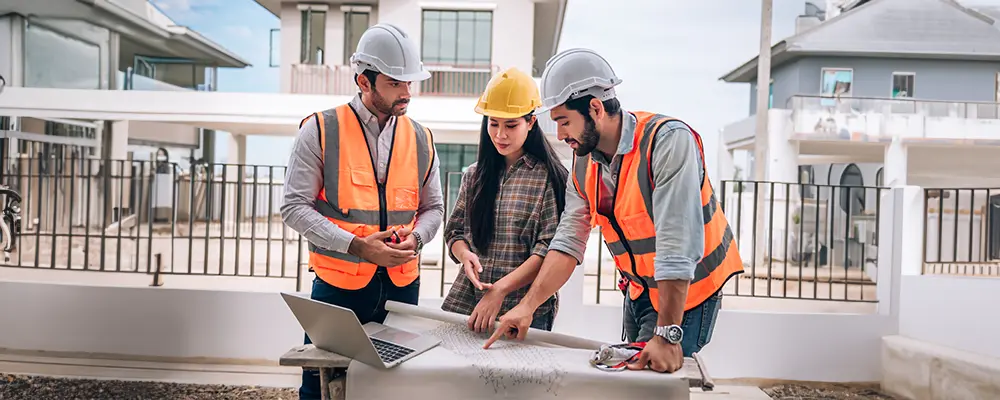The two main approaches are the design-build and design-bid-build project delivery methodologies. Despite their identical names, each method differs greatly from the other. The relationship and responsibilities of the construction team distinguish design-build from design-bid-build.
The contract covers designers and developers in design-build projects, and project phases occur concurrently. However, for design-bid-build projects, builders and designers are hired independently. Project phases are specified and occur one after the other.
They have diverse team structures, adhere to different approaches, and have certain benefits and drawbacks. The best approach will be determined by the owner’s objectives and the project’s scope, risk, and complexity.
In this blog, Brick & Bolt explain choosing the right project delivery method and the advantages and disadvantages of design-build and design-bid-build.
What is Design-Build?
Design-build projects are managed by one organisation. To provide design, engineering, and implementation services, the builder and designer collaborate closely throughout this process. This strategy is defined by the early and regular collaboration between estimators, builders, architects, engineers, trades, and construction disciplines.
Advantages of Design-Build
1) Work Quality

When you choose a contractor up front, you do so based on quality and qualifications rather than cost. Quality builders don’t aim to fulfil the bare minimum; instead, they surpass performance expectations.
2) Quicker Schedule
Time is saved by avoiding the bid process. Simplifying decision-making also comes from working with a single, cooperative team from the start. According to CII research, “The greatest chance of succeeding in achieving goals in schedule maintenance, construction speed, and intensity is with an experienced design-build team.”
3) Regular Budget
This approach moves some project expenditures to the early design stages. However, studies indicate that involving the contractor early results in a more dependable budget. Teams that collaborate early on can uncover problems, discuss ideas, and voice concerns while the project is still conceptual. What good is the lowest bid if the project’s cost rises?
4) Decreased Owner Risk
Contractually, the parties agree to provide a design that satisfies the owner’s requirements. This removes the possibility of disputes between contractors, architects, and owners. Additionally, the owner is spared from mediating the designer-to-builder design hand-off.
5) Streamlined Communication
Many jobs become easier when the designers and builders are present simultaneously. Additionally, the results are superior when they can cooperate and work as a team throughout the project.
Disadvantages of Design-Build
1) No Competitive Bids
The owner could not receive the best rate because projects aren’t chosen based on the lowest bid.
2) More Difficult to Price Shop
Bundling eliminates the opportunity to choose a contractor based on price and the bidding process. Shopping around is also more difficult because many design-builders will start working on a full design after they are hired.
3) Insufficient Flexibility in the Contract
When you “bundle” services, you commit to just one supplier. This requires great trust.
4) Reduced Originality
There is less time for creativity and innovation because the project timeframe is faster with overlapping phases. Usually, design-builders offer a universally applicable answer.
What is Design-Bid Build?
The most common project delivery mode, design-bid-build, attracts bidders seeking low prices. Using this approach, the owner hires builders and designers independently. The design company provides 100% complete design documents. Subsequently, the owner requests quotes from contractors to carry out the specified scope of work.
Advantages of Design-Bid Build
1) Competitive Bids
You will get the most competitive pricing since contractors compete to win the job.
2) Architect Involvement

Architects have a professional responsibility to create a design on behalf of the owner. Since the build-out has no agenda, it will likely provide the highest-quality and most objective drawings.
3) Distinct Roles
Since design and construction roles are independent, defining ownership is clear-cut. Responsibility and legal responsibility are apparent.
4) More Control
While both methods require owner input, design-build gives the owner much more control. They pick their vendors every step of the way and can change that lineup at any stage.
Disadvantages of Design-Bid Build
1) Additional Change Orders
Variations or errors in the scope may result in issues because contractors will only submit bids on work specifically specified in the documentation. If expectations don’t match, this doubts accountability, causes timetable delays, and results in expensive modification orders.
2) Behind on Defining the Budget
Construction prices will be set in stone only after the design phase. If bids exceed the budget, the owner will bear the expense of redesigns, value engineering, and rebidding. Delays of this magnitude may result.
3) Extended Schedule
The design-bid-build process takes longer when the bid phase is added. Because the process is linear, any delay will cause the project as a whole to regress. Further factors that can cause project delays include redesigns, modification orders, and poor communication.
4) Absence of Product Logistics Knowledge
Architects need insight into product availability, shifting market prices, or logistical coordination because they aren’t involved in the execution and implementation phase. They might create a solution without considering systems that might be back ordered or the price of copper. Please consider this to avoid delays, extra expenses for expedited shipping, and redesigns.
Which Method is Best For Your Project?
These drawbacks have raised questions about the design-bid-build approach in recent times. Although design-build projects achieve better cost-quality balances, the conventional design-bid-build process is still needed.
Design-build would be a better option if…
- Players working together would make your complicated project run more smoothly.
- You must adhere to an accelerated timeline or are concerned about the schedule.
- Your top priorities are the deliverables’ quality and cost.
- You wish to take less chances and get less involved.
Design-bid-build would be a better option if…
- Your project will likely undergo design revisions. Thus, cooperation and the knowledge of subcontractors are optional.
- Due to the simplicity of your project, competitive bidding is the only option to keep costs under control.
- You want each player to “stay in their lane” and be at ease with the individual players.
- A longer project timeframe is fine for you.
- You’re employed on a public project that needs to go through a fair bidding procedure.
You can construct your project with assurance using the appropriate project method. Ultimately, these two project delivery methods have operated for hundreds of years. Both are excellent choices. In the end, everything hinges on what matters most to you:
- Is project control the most crucial thing?
- Do you desire excellent communication and flow throughout?
- Can you pay more if it means the project will be finished sooner?
You’ll know where you stand once you start responding to these questions.
FAQs
What is the difference between DBB and EPC?
- DBB (Design-Bid-Build): The project is divided into three phases using this method. First, the design is completed. Then, contractors bid on the project. Finally, the winning contractor builds the project.
- EPC (Engineering, Procurement, Construction): One company is responsible for everything in EPC. It must design, procure materials, and construct the project. This is often used for complex projects. It’s faster because a single contractor handles all tasks.
What is another name for design-build?
- Another name for design-build is “Design and Construct” or sometimes just “D-B.”
Is EPC the same as design-build?
- EPC is similar to design-build, but EPC is more comprehensive. In EPC, the contractor designs, builds, and procures all materials. Design-build focuses more on the design and construction parts, often without the procurement step.
How does the project schedule differ between Design-Build and Design-Bid-Build?
- Design-Build: The project schedule is usually faster. Design and construction happen at the same time, with one team handling everything.
- Design-Bid-Build: The schedule takes longer because each phase (design, bidding, and building) happens in sequence, with different teams at each stage.

